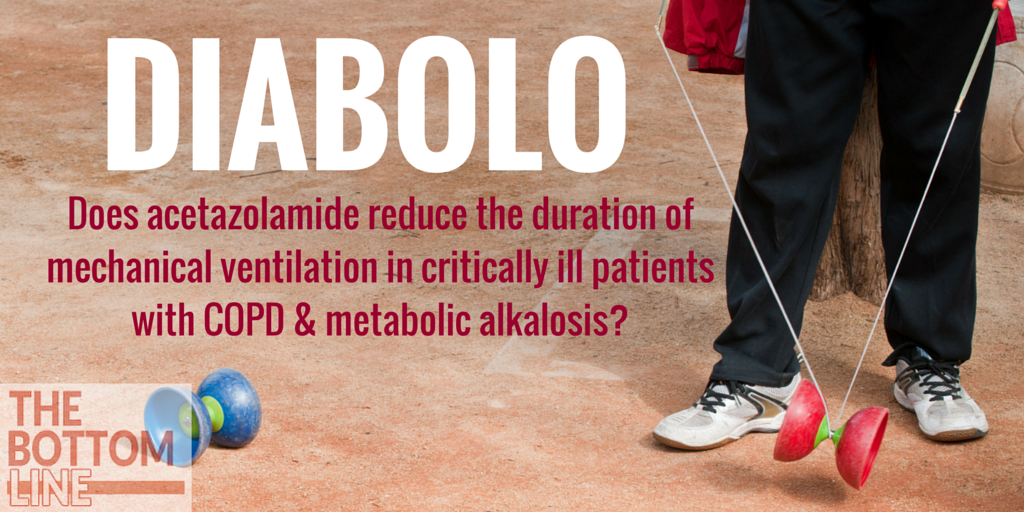DIABOLO
Effect of Acetazolamide vs Placebo on Duration of Invasive Mechanical Ventilation Among Patients with Chronic Obstructive Pulmonary Disease
Faisy. JAMA 2016; 315 (5):480-488. doi:10.1001/jama.2016.0019
Clinical Question
- Does acetazolamide reduce the duration of mechanical ventilation in critically ill patients with chronic obstructive pulmonary disease (COPD) and metabolic alkalosis?
Design
- Randomised controlled, double blinded multi-centre study
- Intention to treat analysis
- Centralised computer generated allocation with 1:1 randomisation and stratified for centres, pre-admission respiratory status and illness severity
- Baseline characteristics: mean age 69 years; male preponderance (72%); Similar SAPS II (mean 50) and SOFA Scores (mean 7.2); requirement for invasive ventilation was pneumonia in > 80%; laboratory measurements at inclusion were all similar
- Sample size calculated a priori. 380 patients were required to achieve 80% power to detect a 15% relative risk reduction in primary outcome measure with the use of acetazolamide (based on preliminary study)
Setting
- 15 ICUs in France
- October 2011 – July 2014
Population
- Inclusion: age > 18 years of age with history of COPD receiving mechanical ventilation via endotracheal or tracheostomy tube for < 24 hours; pure or mixed metabolic alkalosis (serum bicarbonate >26mEql/L and arterial > pH 7.35)
- COPD defined according to American Thoracic Society
- Baseline respiratory status prior to hospitalisation: no respiratory assistance, oxygen requirement, NIV, tracheostomy, or ventilation with tracheostomy
- Exclusion: pregnancy, cystic fibrosis or diffuse bronchiectasis, previous allergy to acetazolamide or sulfonamides, recent participation in another study requiring ventilation, not for resuscitation order.
- 380 patients
Intervention
- Acetazolamide for a maximum of 28 days
- 500 mg twice daily or 1000mg intravenously twice daily if concomitant loop diuretic administration
- 27% of patients were also receiving loop diuretics
Control
- Placebo (saline) for a maximum of 28 days
- Equivalent volume of saline as the intervention group administered twice daily intravenously
Management Common to Both Groups
- Readiness to wean from ventilator was defined according to the criteria of the 6th International Consensus Conference on ICM (2005). Weaning strategy consisted of:
- ready to wean based on following criteria
- resolution of the factor triggering the acute respiratory insufficiency; no sedation and GCS > 12; absence of excessive tracheal/bronchial blockage and an effective cough reflex; haemodynamic stability, temperature <38.5C, systolic blood pressure 90-160mmHg
- progressive decrease of pressure-support or volume-assisted ventilation with progressively longer times on a T-piece
- patients were extubated when they tolerated, for at least one hour, a spontaneous breathing trial via a T-piece with the same inspiratory oxygen fraction (FiO2) used during mechanical ventilation
- ready to wean based on following criteria
Outcome
- Primary outcome: No statistical difference in the median duration of invasive ventilation between groups
- 136.5 hours (IQR 68.7 – 234.7 hours) in the acetazolamide group vs. 163.0 hours (IQR 86.2 – 242.9 hours) in the placebo group; P=0.17
- Secondary outcomes:
- Daily median serum bicarbonate change (mEq/L)
- Reduction in bicarbonate in acetazolamide group: -0.3 vs. 0.3; P=<0.001
- Median number of days with a metabolic alkalosis was fewer in acetazolamide group
- 2 vs 4 days; P=<0.001
- Daily median PaO2:FiO2 ratio change (mmHg)
- Increased in acetazolamide group: 7.8 vs. 3.5; P=0.009
- Daily median change of respiratory parameters
- No statistical difference between groups in tidal volume, respiratory rate or minute volume
- Other secondary outcomes: no statistical difference
- daily median change of PaCO2 and pH
- duration of weaning off invasive ventilation
- numbers of spontaneous breathing trials
- use of tracheostomy or noninvasive ventilation after extubation
- successful weaning rates (invasive ventilation not required 48 hours after extubation)
- days of metabolic alkalosis
- unplanned extubations
- ventilator-associated pneumonia episodes
- other laboratory parameter values
- ICU length of stay
- ICU Mortality
- Daily median serum bicarbonate change (mEq/L)
Authors’ Conclusions
- Among patients with COPD receiving invasive mechanical ventilation, the use of acetazolamide, compared with placebo, did not result in a statistically significant reduction in the duration of invasive mechanical ventilation
Strengths
- Trial registered criticaltrials.gov (NCT01627639)
- Randomised controlled trial
- Multicenter
- Intention-to-treat analysis
- Study drugs were prepared and blinded in pharmacy. Acetazolamide was supplied as a freeze-dried powder but was reconstituted in saline in pharmacy and then administered immediately on ICU. The placebo was administered in the same manner
- Baseline laboratory measurements were well matched
Weaknesses
- Presence of mixed metabolic alkalosis in the majority of patients
- Other factors may have influenced the discontinuation of mechanical ventilation e.g age, airflow limitation, long-term glucocorticoid use, diaphragm atrophy, nutritional status and clinical course (although there were no baseline imbalances so these factors are probably nullified by the randomisation and stratification of patients by ‘respiratory status of patients before hospitalisation’)
- A 16 hour difference may be of clinical significance and it is possible the trial was underpowered to detect a statistical difference..
- The degree of metabolic alkalosis at baseline was mild (bicarbonate 26mmol/L, pH7.32) and thus the clinical effect of acetazolamide may be difficult to assess as these patients do not have profound metabolic disturbance
The Bottom Line
- Acetazolamide administered to patients with COPD and a metabolic alkalosis (primary or mixed), receiving invasive mechanical ventilation, does not result in a statistically significant reduction in the duration of invasive mechanical ventilation. I will continue not to use acetazolamide in this patient group.
External Links
- [abstract] Effect of Acetazolamide vs Placebo on Duration of Invasive Mechanical Ventilation Among Patients with Chronic Obstructive Pulmonary Disease
- [further reading] Acetazolaminde. Life in the Fast Lane
- [further reading] Weaning from Mechanical Ventilation. Boles
Metadata
Summary author: Steve Mathieu
Summary date: 16th February 2016
Peer-review editor: Celia Bradford






